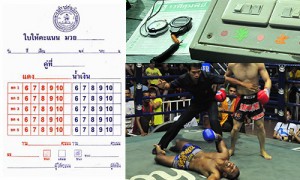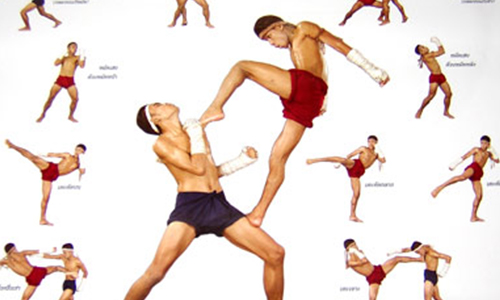Tag Archives: rules in Muay Thai
Muay Thai Rules Part II
In the previous post, the rules 1 to 12 were discussed. We will continue with the remaining set of rules in Muay Thai in this post to fully equip anyone planning to learn Muay Thai with the general rules governing the sport. Here are rules 13 to 21:
Rule No. 13 – The Score Judges
There are two score judges in every Muay Thai fight. They will be seated at the opposite side of the ring, far from the public. It is within the discretion of every score judge to give score within the limitations of the rules. Points will be given to each fighter at the end of each round and will be written on the score sheet, adding them up at the end of the fight. The score judges will write the name of the winner and sign the score sheet before giving it to the referee judge.
Rule No. 14 – The Timekeeper
A time keeper’s duty is to oversee the number of rounds and the intervals between the rounds. This is done by sitting on one side of the ring; five seconds before the start of each round, signal the corner men out of the ring; strike the gong or ring the bell to signal the beginning and end of each round; in case of temporary stoppage or upon order of a referee, deduct the time; keep the accurate time on the watch or clock throughout the fight; give the hand signal to the referee for every second, when the referee is counting in case of a knockdown; making sure that the bell is not rung until the end of the three minutes time, when a boxer falls towards the end of a round which is not the final round and the referee is counting. Bell is rung when the referee orders “box” signaling the continuation of the fight. The interval between the rounds should be the full 2 minutes.
Rule No. 15 – The Decision
The decision should be made as per the following principles:
- KO or knockdown victory is declared when the opponent falls onto the floor; leans unconscious on the ropes; unable to box or defend himself within 10 seconds when the referee judge starts count of 1 to 10.
- TKO or technical knockout victory is declared when the referee judges sees no way for the opponent to win, being in an unfavorable position; when the boxer is not able to resume boxing immediately after the end of the rest interval; when the boxer’s injury or wound is deemed serious that could result in damaging harm if he continues the fight – this will be determined by the stadium physician before a decision is made.
- Victory on Points or a Draw. The decision should follow the majority panel at the end of the fight. If both fighters sustain serious wounds, and are not able to continue boxing, a draw will be declared, unless there has been a special agreement.
- Victory is declared when the opponent concedes the fight.
- Victory through the opponent’s disqualification. Victory may be declared when the opponents violates the rules causing his disqualification. The referee will declare the other fighter as the winner.
- No Decision on the Winner or the Loser. A No Decision will be declared when the stadium is damaged; the spectators are unruly preventing the continuing the fight; one boxer or both boxers connive or perform a sham fight or pretend to commit a foul.
Rule No. 16 – The Scoring Procedure
The following scoring procedure is followed:
A. Points from a strike either by a punch, kick, knee or elbow.
- Scoring from a Strike. Points are scored for correct Thai Boxing style, combined with hard and accurate strikes; for aggressive and dominating Muay Thai skill; for a fighter actively dominating his opponent; and for the use of traditional Thai style of defense and counterattack. Points are deducted from a boxer who fouls or breaks the rules.
- Non-scoring strikes include a strike which is against the rules; a strike in defense against the leg or arm of an opponent, and a weak strike.
B. Fouls. Points will be deducted for any foul as directed by the referee. Any foul observed by the judges, but not by the referee will be penalized accordingly.
C. Method Of Scoring. The maximum score for each round is 10 points. The winning fighter gets 10 and the loser scores 9 or lower. In case of a Draw, 10 points will be scored for each boxer. For a No Decision Round, the winning fighter scores 10 while the loser scores 9. For a Decision round, score will be 10:8 for the winner and loser, respectively. For a No Decision round with a single count, winner scores 10 and loser scores 8. For Decision round with single count, winner gets 10 and loser gets 7. The boxer scoring 2 counts against his opponent will score 10:7. Any boxer who commits a foul will have points deducted from his score.
Rule No. 17 – The Proper and Point-Scoring Actions
The scoring of points in Muay Thai is done in conformity with the Thai boxing style. The fighter shall hit, punch, kick, thrust kick, hammer, stab a kick against the opponent etc in whatever way so as to drain the opponent’s strength. Point scoring principles follow Rule No. 16.
Rule No. 18 – Fouls
If the fighters disobey the order of the judge, violates the competition rules in an unsportsmanlike manner, or commits a foul, the referee judge has the power to caution or to declare the forfeiture of the match without giving a prior warning depending on the seriousness of a foul or the circumstances surrounding it.
Fighter will be penalized by deducting 1 point for each time committed.
- Head-butting, biting, eye gouging, or spitting
- Deliberately falling on his opponent.
- Wrestling, back or arm locks or any similar judo or wrestling hold.
- Use of abusive language or swearing during the match.
- Holding the ropes for any reason.
- Causing injury or knocking out the opponent after the referee has ordered the match to stop for any reason.
- Deliberately striking the groin area.
A boxer who has been hit in the groin, may request a 5 minute break before continuing the match.
Rule No. 19 – Fall
- If any part of the boxer’s body except the feet, touches the floor, or leaning or collapsing on the ropes, knocked out of the ring, or unable to defend himself, he is deemed to fall.
- In case of a fall, the referee judge should start counting while the opponent should move to a far corner immediately.
- When the fallen boxer has arisen and received the “box” instruction from the referee, the fight will resume. If the opponent does not move to a far corner in accordance with the referee’s order, the referee shall stop counting until such order is complied with. Then he can continue counting from where he stops.
- When a boxer falls down, the referee shall count out loud from 1 to 10 with the pausing gap of 1 second. And for each second counted, a hand signal will be given by the referee to make known to the fallen boxer that he is being counted out. Before the count of one, a lapse of 1 second should be allowed from the floor. Only then should the referee start the count with one.
- If the fallen boxer stands up before the referee reaches the count of eight, the referee shall continue counting up to 8 before allowing the fight to resume. But if the referee has already counted to ten before the fallen boxer rises up, the match shall be deemed to be over. The fallen boxer shall be given the decision of defeat by knockout.
- If the fallen boxer can arise before the count of ten but falls down again without being punched, the referee must continue counting.
- It is the discretion of the referee to count or not if the boxer cannot resume boxing immediately after the expiry of the rest interval.
Rule No. 20 – Shaking Hands
The fighters will shake hands at the beginning of the first round after rules are clarified by the referee and before the start of the last round to symbolize that they will compete under the spirit of sportsmanship. Shaking hands during the match is forbidden.
Rule No. 21 – Interpretation
Any interpretation of the above rules or any problems arising during the competition although not governed by any existing rules shall be decided by the referee.
In any type of sports, rules are made to ensure a fair decision will be made in each fight. Rules are also made to guide every fighter on what should be and should not be done to the opponent to avoid getting disqualified or incur foul moves. This concludes our article about the Rules in Muay Thai. In case you missed the first half, you can click here to read it.
Rules in Muay Thai
Muay Thai is a combat sport practiced in various countries all over the world. Each country differ in rules set by the organization which arranges the fight. There are 24 rules observed in every Muay Thai fight in Thailand. The first 12 will be discussed in this post. Here are the following rules:
Rule No. 1 – The Ring
 In Muay Thai ordinary competition, the ring should be square measuring 20 feet on each side for the small ring, and 24 feet on each side for big rings. Measurements take the inside of the ropes. There should be three ropes with a diameter of at least 1.90 centimeters and each rope is tied to the posts at the height of 18 inches, 35 inches and 52 inches respectively. The ropes are insulated with soft material and the inside of the four corners are also covered with soft material. Raised at least 4 to 5 feet at most, from the ground unobstructed, the edge should protrude at least 70 cm from the ropes. The posts should be of 4 x 4 inches and not higher than 58 inches from the ring floor. The floor should have a layer of soft rubber sheet, cork board or straw mat not less than 1.5 inches thick, covered by canvas tightly stretched to cover the whole ring area. Two ladders should be installed not less than 3.5 feet at the opposite ends to allow the officials, trainors and officials.
In Muay Thai ordinary competition, the ring should be square measuring 20 feet on each side for the small ring, and 24 feet on each side for big rings. Measurements take the inside of the ropes. There should be three ropes with a diameter of at least 1.90 centimeters and each rope is tied to the posts at the height of 18 inches, 35 inches and 52 inches respectively. The ropes are insulated with soft material and the inside of the four corners are also covered with soft material. Raised at least 4 to 5 feet at most, from the ground unobstructed, the edge should protrude at least 70 cm from the ropes. The posts should be of 4 x 4 inches and not higher than 58 inches from the ring floor. The floor should have a layer of soft rubber sheet, cork board or straw mat not less than 1.5 inches thick, covered by canvas tightly stretched to cover the whole ring area. Two ladders should be installed not less than 3.5 feet at the opposite ends to allow the officials, trainors and officials.
Rule No 2 – Gloves
Gloves should weigh not less than 4 ounces and not more than 6 ounces. Boxers should not change the shape, twist or crush the glove stuffing into distortion.
Rule No. 3 – The Hand Bandage
A standard surgical hand bandage of not more than 2 inches will follow the length requirements – 10 yards for flyweight to middleweight; 12 yards for light heavyweight to heavyweight. A plaster bandage may be used provided it is 1 inch wide and not less than 12 inches in length. Boxers are not allowed to use plaster bandage to bound round knuckles.
Rule No. 4 – Dress
Fighters must be dressed as follows:
- Groin protector is a must while mouth guard is optional.
- The pair of shorts which is either red or blue should be the same length as the upper thighs.
- No shirt and shoes shall be worn.
- The cotton laurel is put on only during the wai kruu. Cloth talisman tied to the upper arm or waist is allowed.
- Ankle support is allowed. Ankle bandage is not allowed
- Belt, necklace or any metal material is not allowed to be worn
- Use of Vaseline oil, herbs or any other scented material which opponent might consider repugnant is not allowed
Rule No. 5 – The Ring Equipment
 The following equipment should be seen at the ring – 2 seats, 2 bottles of water, 2 jugs, 2 buckets of water, 2 stools, and desks and chairs for the officials, gong with hammer or bell, 1 or 2 time clocks, score sheets and first aid kit and a microphone.
The following equipment should be seen at the ring – 2 seats, 2 bottles of water, 2 jugs, 2 buckets of water, 2 stools, and desks and chairs for the officials, gong with hammer or bell, 1 or 2 time clocks, score sheets and first aid kit and a microphone.
Rule No. 6 – Divisions and Weights
The divisions with their corresponding weight are as follows:
- Maximum of 118 pounds for Bantamweight
- 126 pounds for Featherweight
- 135 pounds for Lightweight
- 147 pounds for Welterweight
- 160 pounds for Middleweight
- 175 pounds for Light Heavyweight
- More than 175 pounds for Heavyweight
Age range of fighter should be between 17 years and 40 years of age.
Rule No. 7 – Weight Measurements
Weighing in happens between 9 and 12 hours prior to the competition start. If weight is over the limit, 12 hours will be given to have a second weighing in. If weight is not the correct weight, weighing in is deemed terminated. Weighing in can be done naked or in boxing attire minus the gloves. Fight will start only at least 3 full hours after the end of weighing in time. Proper examination on health condition of the fighters will be done by the appointed physician. Fighters must compete in one division only. A champion in the lower division may compete in a higher division.
Rule No. 8 – Number of Rounds
Regular competitions shall have no more than 5 rounds of three minutes per round and a minimum of three rounds. For championship final fight, there shall be no more than 6 rounds of 3 minutes each; 5 rounds minimum is required. Wai Kruu dance will be performed before the first round as per tradition. The fight can start only after the dance.
Rule No. 9 – Corner Men
Each fighter can have 2 corner men provided the corner men are not allowed to assist, advise or support the boxer while fighting; the corner men shall not be entitled to concede defeat on behalf of the fighter unless with a special agreement to that effect; the corner men and their assistants are not allowed to stay on the side of the ring before the start of each round – they shall remove towels and buckets, etc from the ring; the corner men must be politely dressed according to boxing standards, not allowing any publicity of any goods on the clothing except the name of the training camp; for the final fight, 3 corner men will be allowed for each fighter but the 3rd man can be on the platform outside the room while the 2 corner men stays inside the ring; if found to violate any rules, the corner men may be cautioned or stripped off the right to be corner men.
Rule No. 10 – The Judging Panel
The fight should have three judges – a referee judge and 2 score judges. These judges should be qualified by their long experience in the profession.
Rule No. 11 – The Referee Judge
 The referee judge is duty bound to make sure that the fight in the ring proceeds fairly and is following the rules. The referee should caution the fighter or corner men who do not follow the rules. He should also mark the score on the scorecard at the end of each round and check the scores on the judge’s scorecards at the end of the fight and announce the winner. He will also facilitate sending the checked score cards to the stadium master. The referee will use three words of instruction during the fight, namely, “stop”, “box” and “break”. The referee should point out some rules to the fighters and head corner man before the start of the first round.
The referee judge is duty bound to make sure that the fight in the ring proceeds fairly and is following the rules. The referee should caution the fighter or corner men who do not follow the rules. He should also mark the score on the scorecard at the end of each round and check the scores on the judge’s scorecards at the end of the fight and announce the winner. He will also facilitate sending the checked score cards to the stadium master. The referee will use three words of instruction during the fight, namely, “stop”, “box” and “break”. The referee should point out some rules to the fighters and head corner man before the start of the first round.
Rule No. 12 – Powers of the Referee
It is within the referee’s power to stop the fight if he deems the fight is not fair in terms of level of skills; if the fighter is so wounded and should not be allowed to continue; if the fighters are not performing seriously in which case the referee may expel one or both fighters. The referee can get the fighter to stop the fight so as to warn him in case he breaks the rules or enable the fight to continue fairly and following the rules. The referee can expel the fighter or the corner men who break the Muay Thai rules; expel the fighter who commits a foul from the other fighter regardless if he has been warned or not. The referee’s decision is deemed final. He shall interpret the rules as stipulated and can deliberate on a course of action based on the facts even if not governed by the rules.
These rules are imparted during Muay Thai training in any gym in the Kingdom to prepare the fighter in case the fighter decides to fight professionally. It is important to know the rules while on training to refrain from committing violations or worse case scenario, be thrown out of the a fight because of foul violations.






